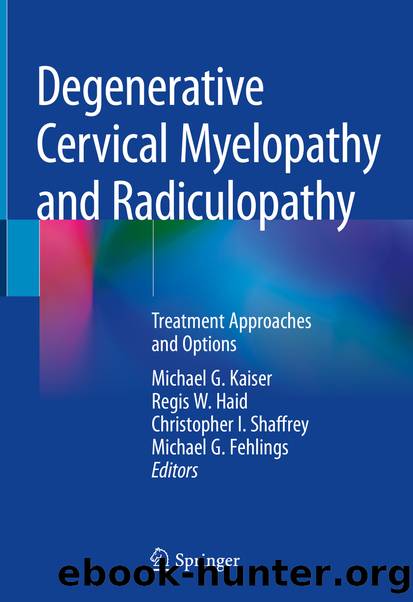Degenerative Cervical Myelopathy and Radiculopathy by Unknown

Author:Unknown
Language: eng
Format: epub
ISBN: 9783319979526
Publisher: Springer International Publishing
Preoperative Evaluation
A comprehensive evaluation of the patient should be performed prior to performing laminoplasty. The evaluation should include a detailed clinical questionnaire, a thorough physical examination, and appropriate diagnostic imaging modalities. A detailed review should include the documentation of all cervical spine-related symptoms, especially symptoms indicating progressive spinal cord compression. Timing, onset, chronicity, exacerbating factors, the overall course and trajectory, history of falls, changes and bowel and bladder function, the presence of axial neck pain, and the distribution of arm pain are essential to document. Physical exam should document range of motion of the neck, gait pattern, muscle weakness in upper or lower extremities, and signs of upper motor neuron dysfunction such as hyperreflexia and Hoffmannâs or Babinski reflex. The radiographic evaluation of patients for whom laminoplasty may be considered includes standard anterior-posterior (AP) and lateral radiographs, flexion and extension lateral radiographs, and oblique radiographs (to visualize the neural foramen) of the cervical spine. These are used to assess cervical alignment, ROM, degenerative changes, instability and spondylolisthesis, underlying congenital stenosis, foraminal stenosis, autofusions, and other pathologies of the cervical spine.
Magnetic resonance imaging (MRI) is used to evaluate the severity and craniocaudal extent of stenosis as well as study contributing etiologies such as disk bulging, uncovertebral and facet arthrosis, hypertrophy and infolding of the ligamentum flavum, underlying congenital stenosis, deformity, or ossification of the posterior longitudinal ligament (OPLL) . Computed tomography (CT) of the cervical spine is indicated for the evaluation of bony or calcified causes of stenosis, including OPLL and uncovertebral or facet arthrosis causing foraminal stenosis. CT myelography is indicated when MRI is contraindicated or cannot be obtained. If a CT scan is obtained, a topographic reconstruction of the posterior cervical spine may provide reference landmarks that supplement intraoperative fluoroscopic examination.
Download
This site does not store any files on its server. We only index and link to content provided by other sites. Please contact the content providers to delete copyright contents if any and email us, we'll remove relevant links or contents immediately.
What's Done in Darkness by Kayla Perrin(25500)
Shot Through the Heart: DI Grace Fisher 2 by Isabelle Grey(18220)
Shot Through the Heart by Mercy Celeste(18160)
The Fifty Shades Trilogy & Grey by E L James(17775)
The 3rd Cycle of the Betrayed Series Collection: Extremely Controversial Historical Thrillers (Betrayed Series Boxed set) by McCray Carolyn(13189)
The Subtle Art of Not Giving a F*ck by Mark Manson(12912)
Scorched Earth by Nick Kyme(11832)
Stepbrother Stories 2 - 21 Taboo Story Collection (Brother Sister Stepbrother Stepsister Taboo Pseudo Incest Family Virgin Creampie Pregnant Forced Pregnancy Breeding) by Roxi Harding(11040)
Drei Generationen auf dem Jakobsweg by Stein Pia(10217)
Suna by Ziefle Pia(10186)
Scythe by Neal Shusterman(9263)
International Relations from the Global South; Worlds of Difference; First Edition by Arlene B. Tickner & Karen Smith(8608)
Successful Proposal Strategies for Small Businesses: Using Knowledge Management ot Win Govenment, Private Sector, and International Contracts 3rd Edition by Robert Frey(8419)
This is Going to Hurt by Adam Kay(7695)
Dirty Filthy Fix: A Fixed Trilogy Novella by Laurelin Paige(6453)
He Loves Me...KNOT by RC Boldt(5804)
How to Make Love to a Negro Without Getting Tired by Dany LaFerrière(5378)
Interdimensional Brothel by F4U(5304)
Thankful For Her by Alexa Riley(5161)
